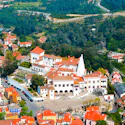Located in the heart of Sintra, is one of the most iconic landmarks of Portugal- the National Palace of Sintra. Also known as the Town Palace, the National Palace of Sintra is the only palace in the entire history of Portugal. Its two conical chimneys are its most distinguishing features and on a clear day, you can easily see them from afar.
Inhabited for almost eight centuries by the Portuguese monarchy and court, the National Palace of Sintra was widely used during the Middle Ages. The National Palace of Sintra served as a hunting retreat and summer resort for the Portuguese nobility and even functioned as a place of refuge for Sintra's population during the outbreak of the disease in the capital.
Why You Must Visit National Palace of Sintra
The National Palace of Sintra or the Palacio Nacional de Sintra is one of the best-preserved medieval royal palaces and is worth a visit if you are in Lisbon, Portugal. A favorite of the Portuguese nobility, the National Palace of Sintra was the residence of the Portuguese monarchy and court from the early fifteenth century through to the late nineteenth century.
The National Palace of Sintra is considered to be one of the best examples of organic architecture and its two massive protruding conical chimneys have become a landmark of the town of Sintra. Over here, you will find the largest set of Mudéjar tiles and a collection of Portuguese decorative art from the sixteenth century to the eighteenth century.
The Palace is filled with memories and has borne testimony to some of the most defining moments in the history of Portugal. So if you want to learn about Portugal’s rich history and its multicultural artifacts and architectural styles, add the National Palace of Sintra to your itinerary.
Our Best Recommended National Palace of Sintra Tickets
While planning your visit to the National Palace of Sintra, choose between skip-the-line tickets and combo deals that let you club your visit to the National Palace of Sintra with either the Pena Palace, Monserrate Palace or the National Palace of Queluz and its Gardens.
National Palace of Sintra's History

The National Palace of Sintra is the oldest in Portugal. The first document that testified to the existence of a palace in Chão da Oliva was found in 1281. According to the document, King Dinis entered into a contract with the free Moors of Colares wherein he agreed to lower their fiscal burden in exchange for their efforts to conserve the palace. Of all the palaces in Portugal, the National Palace of Sintra survives almost intact since its discovery in 1281.
At the end of the Middle Ages, the National Palace of Sintra was the center of a large territory that was under the care of the Queens of Portugal. During this time, the National Palace of Sintra also became the preferred destination for the Portuguese monarchs. The abundance of hunting in the region, the fresh climate during summers, and the need to take refuge during periods of plague all contributed to making the National Palace of Sintra a regular destination and not just a summer or hunting resort.
From the early fifteenth century through to the late nineteenth century, the National Palace of Sintra served as the royal residence of the Portuguese nobility. However, the revolution of 1910 put an abrupt end to the Palace as a royal residence. Queen Maria Pia, who was the widow of King Luìs, was the last royal inhabitant of the National Palace of Sintra, and she eventually left the Palace to go into exile.
National Palace of Sintra's Unique Architecture

The National Palace of Sintra emerges from many royal palaces, but King João can be credited for the original layout of the palace which includes its whitewashed façade, the main entrance, and its central courtyard-’Al Joanina’. The most distinguishing and well-known feature of the National Palace of Sintra is its two large, conjoined, and conical chimneys that can easily be seen from afar. The National Palace of Sintra is a mixture of different architectural styles such as gothic, Manueline, mudéjar, medieval, Renaissance, and romanticism. Not only does this amalgamation of different architectural styles depict the multicultural nature of Portugal but it also reflects the latest architectural trends of the different periods in Portuguese history.
The current structure of the National Palace of Sintra is due to the construction campaigns led by its various royal tenants. King Dinis constructed the Chapel and King João created the quarters around the central patio and the Swan Room. King Manuel I, added the Room of the Coat of the Arms to the National Palace of Sintra, some decorative features, and the Hispano-Moresque tile furnishings. By the end of his reign, the National Palace of Sintra was the most grandiose of all the places in Portugal. King João III built a new palace by connecting the Room of the Coat of Arms with the chambers of Queen Catherine of Austria. In 1910, the National Palace of Sintra was declared a national monument and in 1930, the Palace opened its doors to the public.
Inside the National Palace of Sintra - Highlights

Gardens
The Gardens of the National Palace of Sintra extend across the terraces to the west of the Palace. On the first level is the Preta Garden which is a historical center that has magnificent views of the hills of Sintra. Other gardens that make up the National Palace of Sintra Gardens include the Araucaria garden, Kitchen garden, Princes’ garden, and the Tanquinhos Patio.

Manueline Room
This room depicts three different political realities of Portuguese history. Under the regime of King Manuel I, the Manueline Room depicted the medieval noble regime. From 1822 onwards, the room became less of a royal residence and moved towards a more domestic regime that is closer to the current models. During the Estado Novo time, the room depicted the dictatorial ideology of this group.

Room of the Canopy Bed
The room of the Canopy Bed in the National Palace of Sintra borrows its name from the seventeenth-century canopied bed that is found here. This bed was the property of the Dukes of Cadaval. At the beginning of the twentieth century, the room functioned as a dining room for the staff who were in service of Queen Maria Pia-the last royal inhabitant of the National Palace of Sintra.

Arab Room
The Arab Room in the National Palace of Sintra was the most severely affected in the palace after the earthquake in 1755. This room is a treasure trove of artifacts that display the different histories that made up the reconstruction and reconfiguration of the National Palace of Sintra.

Chapel
The Chapel at the National Palace of Sintra was originally constructed during the reign of King Dinis and Isabel of Aragon. The Chapel played host to simultaneous religious services that paid homage to God and the King. The Mudéjar ceiling in the Chapel is one of the best-preserved architectural features of the National Palace of Sintra.

Chamber of Alfonso VI
The Chamber of Alfonso VI is the oldest section of the National Palace of Sintra. The Chamber of Alfonso VI is a fortified structure that was built to defend the surrounding lands. In Portuguese history, the Queen was the highest authority and her chambers were located in this area. But in the seventeenth century, the chamber became a prison for King Alfonso VI.

Room of Coats of Arms
The Room of the Coats of Arms contains the coat of arms of King Manuel I and his son. It also has the coat of arms of seventy-two of the leading Portuguese noble households. The inscription in this room recalls the memories of the services provided by its ancestors and the walls of the room are painted with scenes of gallantry in the eighteenth century.

The Galley Room
The Galley Room is named so because of the galleys painted on its ceiling. The Galley Room or the Great Hall was the first room of the National Palace of Sintra that was built by King João III. The room interlinks the main chambers of the palace to the south with the north-western wing of the National Palace of Sintra.

The Swan Room
The Swan Room corresponds to the Great Hall in the National Palace of Sintra. During the nineteenth century, the Swan Room brought the court together as a place for banquets, musical concerts, public receptions, religious ceremonies, and even funeral ceremonies.

Palace Guard Room
To access the National Palace of Sintra, visitors had to go past the Palace Guard Room. When the National Palace of Sintra was the royal residence for Portuguese nobility, ceremonial guards would be standing there with halberds in their hands. These weapons soon became a symbol of distinction in Portuguese history.
Best Time to Visit National Palace of Sintra

The best time to visit the National Palace of Sintra is in the spring and early autumn seasons. During this time, the weather is bright and sunny without the extreme summer heat. By visiting the National Palace of Sintra during this time you will be able to avoid the summer crowds that throng the city during the high tourist season from July to August. During this time, the National Palace of Sintra tends to be very busy throughout the day.
The National Palace of Sintra is one of the most visited sights in Portugal and visiting the city during the off-season will not only help you avoid large crowds and long queues but it will also reduce your waiting time at the National Palace of Sintra.
National Palace of Sintra - Opening Hours
National Palace of Sintra Hours
The National Palace of Sintra is open from 9:30am to 6:30pm. The gardens at the Palace remain open from 9am to 6:30pm.
The last ticket and admission to the National Palace of Sintra are at 6pm, so plan your visit accordingly.
How to get to the National Palace Of Sintra
- By Bus:
You can catch bus 434 or 435 from Scotlurb and get off at the Sintra Train station. The National Palace of Sintra is a 10-15 minute walk from the Sintra train station. - By Train:
Hop onto the Sintra Line and take the train CP from Lisbon to Sintra. The departure stations for Train CP are Oriente, Rossio, and Entrecampos. - By Car:
If you are arriving by car or taxi, take the IC19 from Lisbon. If traveling from Mafra, take the IC30. From Cascais, take EN9 and reach the National Palace of Sintra via A5.
Restaurants Near the National Palace of Sintra

The Cantinho Gourmet restaurant is a 2-minute walk from the National Palace of Sintra. The restaurant is known for its delicious food and great service. The staff at the Cantinho Gourmet are very friendly and fun, so you are guaranteed great food and great service.

Just a 2-minute walk from the National Palace of Sintra, you will find the Bacalhau na Vila restaurant. The food over here is super yummy and the staff here is fun and friendly. But you may have to spend some time waiting at the restaurant before being seated.

Another great restaurant that is just a 2-minute walk from the National Palace of Sintra is Piadina’s Wine & Co. The restaurant serves local dishes made from fresh and traditional Portuguese ingredients. Try out their Italian fresh dough Piadinas and their Portuguese and Mediterranean tapas.

The Tasca Saloia restaurant is a 1-minute walk from the National Palace of Sintra. Inspired by the Portuguese concept of ‘petisco,’ you will find some great local and traditional dishes on their menu that are bound to take your senses on a culinary journey exploding with flavor.

The Botica Saloia is another restaurant in Sintra that is just a 1-minute walk from the National Palace of Sintra. Botica Saloia is essentially a wine and tapas bar where you can enjoy local flavors and indulge in some sumptuous Portuguese dishes.
Facts that you probably didn’t know about the National Palace Of Sintra
- The National Palace of Sintra is the oldest in Portugal.
- The Sintra Palace is one of the best-preserved medieval royal palaces.
- The National Palace of Sintra survives intact since it was discovered in 1281.
- The two conical chimneys on the National Palace of Sintra have become an iconic landmark of the town of Sintra.
- The minimalist exterior of the National Palace of Sintra hides some fabulously decorated staterooms.
- The National Palace of Sintra is a mixture of gothic, Manueline, mudéjar, medieval, Renaissance, and romantic architecture.
- The Sintra Palace is one of the most visited places in Portugal.
Insider Tips
- Visit the National Palace of Sintra during the off-season, which is either spring or early autumn.
- Book your tickets for visiting the National Palace of Sintra online and in advance. You can choose from skip-the-line tickets and combo deal tickets.
- Wear comfortable footwear when visiting the palace since you will be walking a lot.
- If you are traveling to the Palace in a private car, park your car in the car park and then proceed to the National Palace of Sintra either on foot or by using public transport.
- The circulation of private vehicles in the surrounding area of the National Palace of Sintra is limited to residents only.
- If available, opt for a guided tour of the National Palace of Sintra to get the most out of your visit to the palace.
- The last ticket and last admission to the National Palace of Sintra are at 6pm, so plan your visit accordingly.
Things To Do Around the National Palace of Sintra
FAQs
The National Palace of Sintra is the oldest in Portugal. It is one of the best-preserved medieval royal palaces and has survived literally intact since 1281. The National Palace of Sintra was also the royal residence of the Portuguese Kings.
You can spend around thirty minutes to one hour exploring the National Palace of Sintra.
Yes! The National Palace of Sintra is open all year round. The Palace remains open from 9:30am to 6:30pm.
Yes you can. Booking skip-the-line tickets for the National Palace of Sintra will give you priority entry to the palace on the day of your visit and will help you jumpstart your visit to the palace by skipping the long queues at the attraction.
The National Palace of Sintra is a spectacular architectural monument located in Portugal. It's one of the most iconic landmarks in the country and has been declared a UNESCO World Heritage Site. Built in the 15th century, it has since become an integral part of Portuguese history and culture.
You can expect to be in awe of the architecture and design of the palace, which includes an unbelievable variety of styles. From its stunning Manueline-style detailing on the façade to its Moorish-style tiles and delicate gothic touches inside, there's something for everyone to appreciate.







